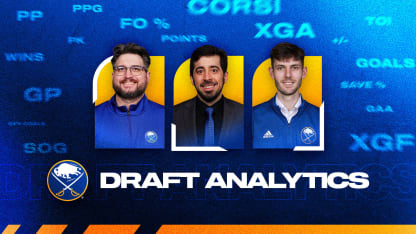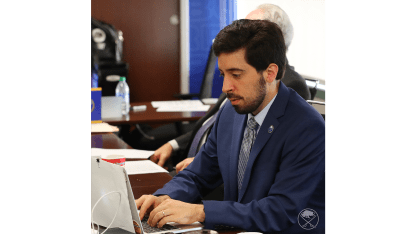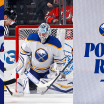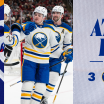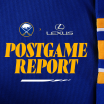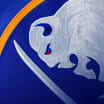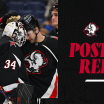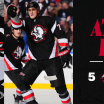The draft-prep process
The analytics team begins its process by collecting data on every draft-year eligible prospect across a variety of metrics and evaluation settings.
With that data, they can narrow the scope of players for Sabres scouts to focus on.
“If you look at draft-year eligible players for this season, there’s like 32,000 players in our data set,” Barlowe said. “If you include plus-1 and plus-2 draft year players that were eligible in earlier drafts, that gets up to like 100,000 players – numbers that are just very hard to watch all at once. A lot of our process is helping – especially later-round picks – whittle those numbers down into manageable numbers that our scouts can then go watch.”
While the scouts go watch the players, Ventura’s team watches the high-quality data it has coming in on each prospect. The challenge is deciding how to appropriately weigh all the information received from each evaluation setting.
NHL teams are scouting draft-eligible prospects playing in over 30 different leagues from all over the world. In Europe, specifically, a variety of factors impact evaluation in a single season, including age of competition, level of competition, and tournament play.
“For some players, we have over 10 different evaluation settings that we are analyzing across the two seasons leading up to their draft, just between the various leagues and tournaments that they play in at different ages,” Ventura said.
The main goal is to identify which players are performing consistently across their various evaluation settings.
“It really starts with having an understanding of who players are as they come into the season and updating our opinions on those players progressively as we get more and more data coming into our systems throughout the season,” Ventura said.
Ventura’s group has developed models that project future player performance, placing more emphasis on certain areas of the game. The process helps Ventura, Galamini Jr., and Barlowe track metrics that players can control, like effort, to pick out which players who exemplify the characteristics that correlate with success in the NHL.
“That extra data kind of helps us tease out those players who score a lot of goals but also do all these extra things that translate well to NHL success, the players you would want on your team in the playoffs,” Barlowe said.
Benson, for example, met many of the team’s criteria despite being an undersized forward in the draft.
“Not only did he bring offensive production both as a goal scorer and as a playmaker, but Zach had a knack for contributing in a number of areas,” Galamini Jr. said. “For example, winning puck battles, managing the puck and playing a sound defensive game. He did things that are sought-after traits at the NHL level and checked a lot of boxes for us.
"But obviously, it gets dicey when you like some aspects of a player, and you don’t like others. And that kind of happens as you get deeper into a draft, you have to live with some of the flaws and try to figure out how everything balances out at the end of the day.”
Ventura and his team then independently evaluate each prospect from a strictly stats perspective, using their agreed upon process and criteria to form their own lists before the larger group gets together. The main challenge is preventing internal bias from coming into play and remaining objective by using the data to tell the story.
The group agrees to not read any scouting reports or watch any video on a player until they form a strong opinion through the data. Often, the analytics team’s opinion of a player will resemble the scouting opinion.
“It’s rare that our description of a player differs in any significant way from a scout’s description of a player,” Ventura said. “And so, I find that our opinion and the scouting opinion have come pretty close together after we’ve developed the models that we’re using for player evaluation now and really built out the depth at which we can look at the details of a player’s game.”

